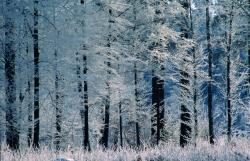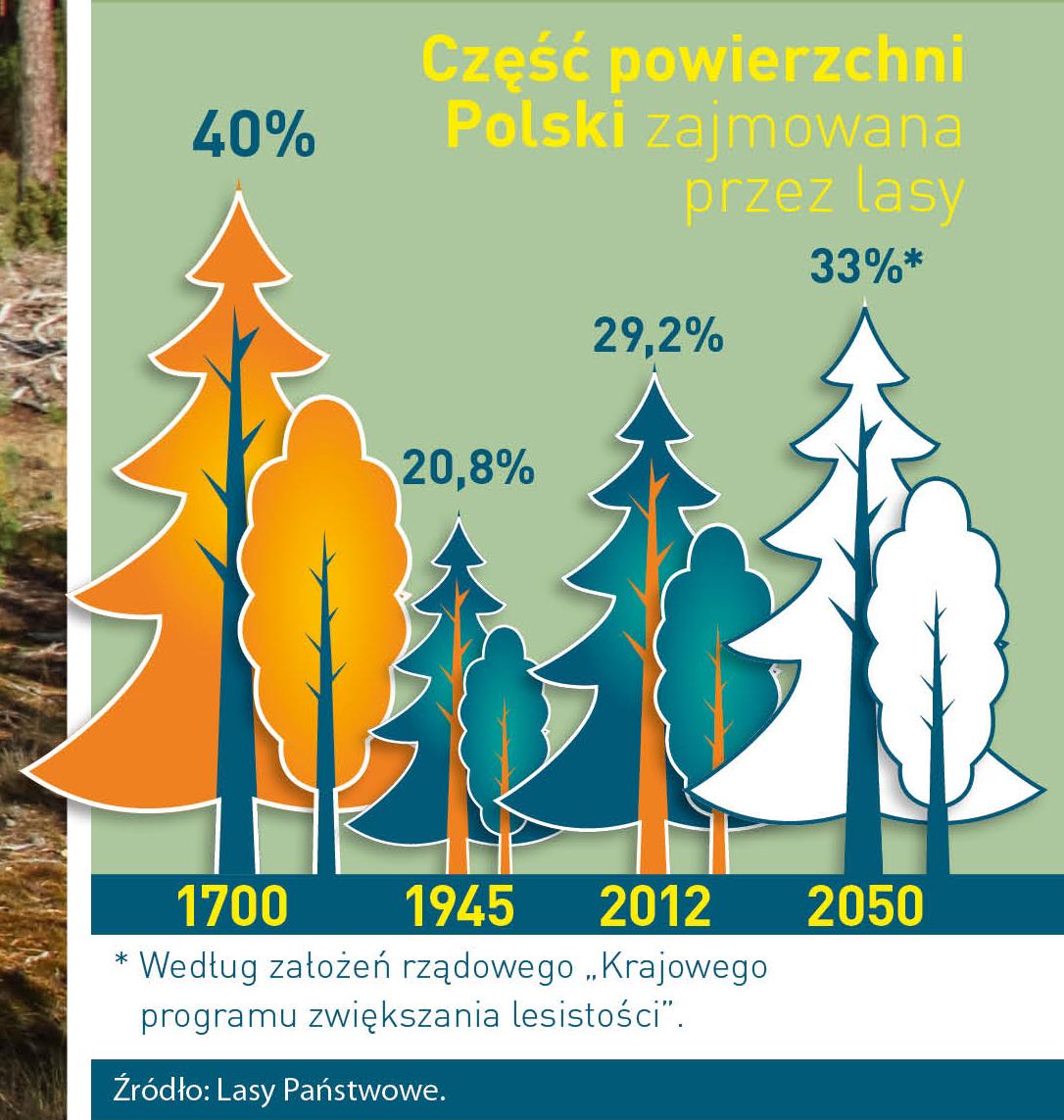 Asset Publisher
Asset Publisher
Polish forests
Poland is in the European lead, while concerning the area of all forests. They cover about 29,2 % of the country territory, and grow within the area of 9,1 million hectares. The overwhelming majority of the forests is state owned, of which almost 7,6 million hectares are managed by the State Forests National Forest Holding..
The number of Polish forest is still growing. The forestation rate of the country has increased from 21 % in 1945 to 29,2 % at the moment. Between 1995 and 2008, the forest area increased by 310 thousand ha. The basis for afforestation works is the "National Programme for Increasing the Forest Cover" (KPZL), assuming an increase of the forestation rate up to 30 % by 2020 and up to 33 % by 2050. Polish forests abound in flora, fauna and fungi. 65 % of the total number of animal species live there.
The forests grow in our country on poor soils, mainly because of the development of the agriculture in previous years. It influences the distribution of the types of the forest sites in Poland. Over 55 % of the forest areas is covered with coniferous forests. In other areas, there are forest sites, mainly the mixed ones. Their small part constitute alder and riparian forests – not more than 3 %.
In the years 1945 – 2011 the area of natural deciduous tree stands within the area of the State Forests National Forest Holding increased from 13 to 28,2 %.
Within the lowlands and uplands the most often occurring tee species is pine. It covers 64,3 % of the forest area of the State Forests National Forest Holding and 57,7 % of private and commune forests. In the mountains the predominant species is European spruce ( in the west) and European spruce with beech (in the east). Domination of pine is the result of carrying on sustainable forest management in the past. Once, the monocultures (crops or cultivations of one species) were the answer to the great demand of industry for wood. Such forests appeared to be quite fragile to climatic factors. They also were often the prey of pests' expansion.
In Polish forests, the share of other tree species, especially deciduous trees have been systematically increasing. The foresters have stepped aside from monocultures – that is why, they try to fit specific species of the forest stand to the natural stand, that would be proper for the given area. Thanks to that, in the years 1945 – 2011, the area of the deciduous tree stands within the lands of the State Forests National Forest Holding increased from 13 to 28,2 %. There occur more and more frequently the following tree species: oaks, ashes, maples, sycamore maples, elms, but also birches, beeches, alders, poplars, hornbeams, aspens, tilias and willows.
Our forests are the most often represented by the forest stands aged 40 to 80 years. The average age of the forest equals 60 years. More and more trees are of big size at the age over 80 years. Since the end of the Second World War, the forests' area has increased up to almost 1,85 million hectares.
Raport o stanie lasów w Polsce 2012
 Asset Publisher
Asset Publisher
 Asset Publisher
Asset Publisher
Nasze lasy
Nasze lasy
Nadleśnictwo Spała prowadzi trwale zrównoważoną gospodarkę leśną na ponad 15,5 tys. ha, a swym zasięgiem terytorialnym obejmuje 454,40km2. Dodatkowo na zlecenie Starostwa Powiatowego w Tomaszowie Mazowieckim pracownicy nadleśnictwa prowadzą nadzór nad lasami nie stanowiącymi własności skarbu państwa na obszarze ponad 2,2 tys. ha.
Tereny Nadleśnictwa Spała rozpościerają się na malowniczej równinie piotrkowskiej, w dolinie rzeki Pilicy, która jest szczególnie bogata w kompleksy leśne. Tereny nadleśnictwa cechują się niewielkim zróżnicowaniem rzeźby terenu. Jest to teren równinny, na którym występują lokalne wzniesienia i pagórki, które osiągają wysokość około 190-200m n.p.m.
Ciekawym elementem terenu jest dolina rzeki Pilicy, która przepływając przez gminę Inowłódz jest granicą rzeźby lodowcowej i przedlodowcowej Polski. To właśnie tam znajdują się najniżej położone tereny Nadleśnictwa o wysokości 143 m n.p.m.
Największym znaczeniem dla obecnego ukształtowania rzeźby terenu oraz budowy geologicznej Nadleśnictwa Spała, miał maksymalny stadiał zlodowacenia środkowo – polskiego. To właśnie z tego okresu wywodzą się najmłodsze na opisywanym terenie osady i formy glacjalne. Na terenie nadleśnictwa można wydzielić następujące jednostki geomorfologiczne:
- wysoczyznę morenową,
- obszary występowania utworów wodnolodowcowych (zandry),
- obszary aluwialnych dolin Pilicy z tarasami: zalewowymi, erozyjnymi i wydmowymi.
Bogactwo gatunkowe lasów (biocenoza) nierozerwalnie związane jest z biotopem, tworząc razem ekosystem leśny. W związku z dużą różnorodnością ekosystemów leśnych wyróżniono kilkanaście typów siedliskowych lasu.
Na terenie nadleśnictwa występuje 12 typów siedliskowych lasu. Na żyznych glebach występują siedliska lasowe, które mają bogatą szatę rośliną i zbudowane są głownie z drzew liściastych. Na siedliskach borowych w Nadleśnictwie Spała króluje sosna.
Oprócz siedlisk typowo leśnych oraz borowych wyróżniamy siedliska mieszane, w których sosna jest również gatunkiem głównym, jednakże duży udział mają tu też gatunki liściaste. Są to głównie: dąb bezszypułkowy i szypułkowy, brzoza brodawkowata oraz buk zwyczajny.
Oprócz drzew na biocenozę ekosystemu leśnego składa się wiele gatunków roślin oraz grzybów występujących w runie leśnym spalskich lasów. Spośród ich dużego bogactwa na terenie nadleśnictwa występuje wiele gatunków objętych ochroną gatunkową.
Najciekawsze z nich to: smardz, szmaciak gałęzisty, porosty z rodziny brodaczkowate, orlik pospolity, grążel żółty i grzybienie białe występujące na stawach starorzecza Pilicy, a także wawrzynek wilczełyko oraz wierzba borówkolistna. Ponadto na terenie Nadleśnictwa Spała występuje wiele okazałych pojedynczych drzew oraz ich grup, które mają miano pomników przyrody.
Także świat zwierząt na obszarze lasów spalskich jest bogaty i zróżnicowany. Gromada ssaków reprezentowana jest przez główne polskie gatunki łowne: jelenia, sarnę, dzika, daniela, zająca, lisa, jenota, borsuka, kunę, norkę, tchórza i piżmaka. Na terenie nadleśnictwa występuje również wiele chronionych owadów, płazów, gadów, ptaków oraz ssaków. Do najciekawszych możemy zaliczyć: kumaka nizinnego(płazy), traszki grzebieniastą oraz zwyczajną (gady), błotniaki, bociana czarnego, świstuna (ptaki), liczne nietoperze z rodziny mroczkowatych gniazdujące w bunkrach, gronostaja oraz łasicę.


 fot. Paweł Fabijański
fot. Paweł Fabijański
 fot. Paweł Fabijański
fot. Paweł Fabijański
 fot. Paweł Fabijański
fot. Paweł Fabijański






